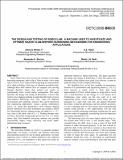The Design and Testing of RoboClam: A Machine Used to Investigate and Optimize Razor Clam-Inspired Burrowing Mechanisms for Engineering Applications
Author(s)
Winter, Amos G.; Hosoi, Anette E; Slocum, Alexander H; Deits, Robin Lloyd Henderson
DownloadThe design.pdf (455.8Kb)
PUBLISHER_POLICY
Publisher Policy
Article is made available in accordance with the publisher's policy and may be subject to US copyright law. Please refer to the publisher's site for terms of use.
Terms of use
Metadata
Show full item recordAbstract
Razor clams (Ensis directus) are one of nature’s most adept burrowing organisms, able to dig to 70cm at nearly 1cm/s using only 0.21J/cm. Ensis reduces burrowing drag by using motions of its shell to fluidize a thin layer of substrate around its body. Although these shell motions have an energetic cost, moving through fluidized rather than packed soil results in exponentially lower overall energy consumption. This paper describes the design and testing of RoboClam, a device that mimics Ensis digging methods to understand the limits of razor clam-inspired burrowing, how they scale for different environments and conditions, and how they can be transferred into engineering applications. Using a genetic optimization solver, we found that RoboClam’s most efficient digging motion mimicked Ensis shell kinematics and yielded a power law relationship between digging energy and depth of n = 1.17, very close to the ideal value of n = 1. Pushing through static soil has a theoretical energy-depth power law of n = 2, which means that Ensis-inspired burrowing motions can provide exponentially higher energy efficiency and nearly depth-independent drag resistance.
Date issued
2009-08Department
Massachusetts Institute of Technology. Department of Electrical Engineering and Computer Science; Massachusetts Institute of Technology. Department of Mathematics; Massachusetts Institute of Technology. Department of Mechanical Engineering; Massachusetts Institute of Technology. Department of PhysicsJournal
Volume 7: 33rd Mechanisms and Robotics Conference, Parts A and B
Publisher
American Society of Mechanical Engineers
Citation
Winter, Amos G., A. E. Hosoi, Alexander H. Slocum, and Robin L. H. Deits. “The Design and Testing of RoboClam: A Machine Used to Investigate and Optimize Razor Clam-Inspired Burrowing Mechanisms for Engineering Applications.” Volume 7: 33rd Mechanisms and Robotics Conference, Parts A and B (2009).
Version: Final published version
ISBN
978-0-7918-4904-0